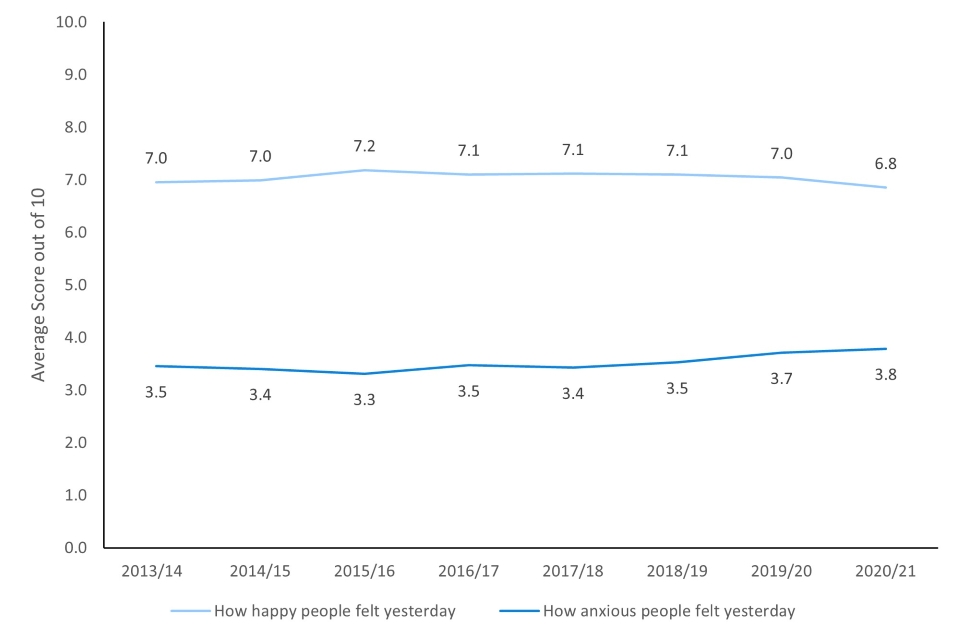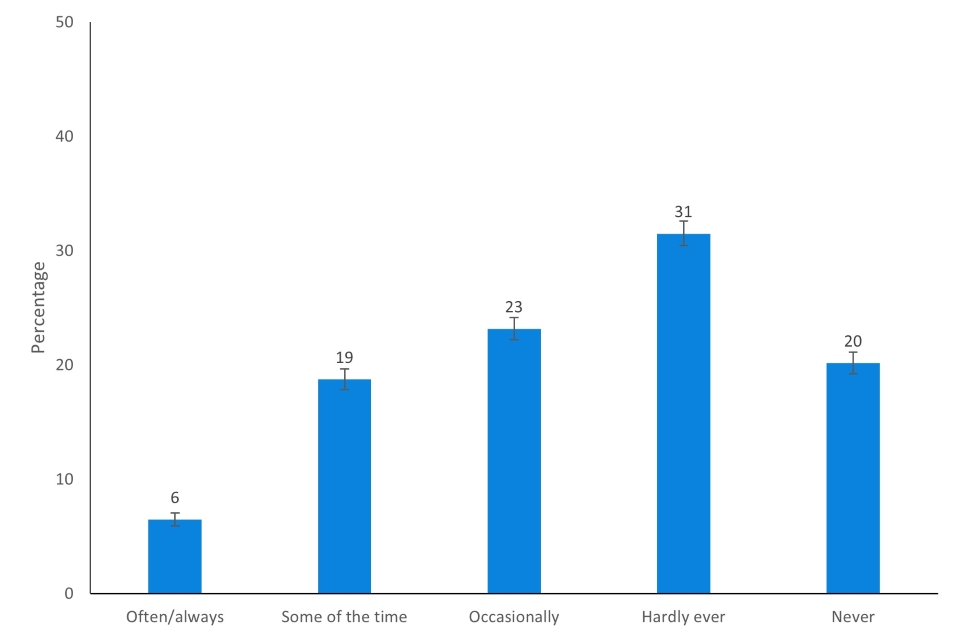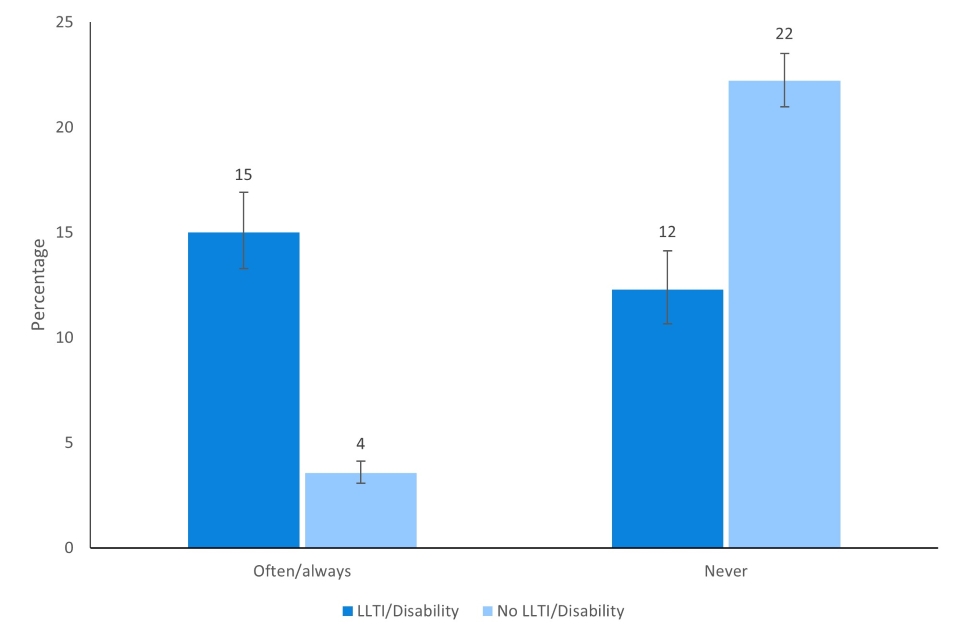Wellbeing and Loneliness - Community Life Survey 2020/21
Published 29 July 2021
Applies to England
The Community Life Survey is a household self-completion survey (online survey, with paper survey for adults not digitally engaged) of adults aged 16+ in England. This chapter summarises results related to wellbeing and loneliness from the 2020/21 survey, which ran from April 2020 to March 2021.
Differences between groups are only reported on in this publication where they are statistically significant i.e. where we can be confident that the differences seen in our sampled respondents reflect the population[footnote 1].
Harmonisation
The Community Life Survey uses the Government Statistical Service (GSS) harmonised principle for the four personal measures of wellbeing and indicators of loneliness. The estimates presented here are therefore comparable with other surveys that use this principle, although we advise taking caution when comparing measures from different surveys due to differences in the methodology (e.g. mode/sampling approach) which will have an effect on estimates .
1. Wellbeing
Two questions were used where respondents were asked about overall wellbeing, and these questions measure responses on a scale from 0 (not at all) to 10 (completely).
-
Overall, how satisfied are you with your life nowadays? (referred to as life satisfaction).
-
Overall, to what extent do you feel that the things you do in your life are worthwhile? (referred to as self-worth)
The mean scores for life satisfaction and self-worth showed a decrease for 2020/21 compared to 2019/20. Out of 10, the average score for life satisfaction was 6.9, whilst the score in 2019/20 was higher at 7.0. In 2020/21, the average score for self-worth was 7.1, compared to 7.3 in 2019/20.
Figure 2.1 - Life satisfaction and self-worth, 2013/14 – 2020/21

Two questions were used which ask about how a respondent felt yesterday, and these questions also measure responses on a scale from 0 (not at all) to 10 (completely).
-
Overall, how happy did you feel yesterday? (referred to as happiness).
-
On a scale where 0 is “not at all anxious” and 10 is “completely anxious”, overall, how anxious did you feel yesterday? (referred to as anxiety).
How happy people felt the day before taking the survey has remained consistent from 2013/14 to 2019/20, with a mean score in 2019/20 of 7.0. However, the mean score has decreased to 6.8 in 2020/21. The mean score for how anxious people felt the day before taking the survey was 3.8 in 2020/21, inline with the average anxiety score in 2019/20.
Figure 2.2 - Time series for feeling happy and anxious, 2013/14 – 2020/21

2. Loneliness
GSS harmonised questions on different aspects of loneliness were included in the 2019/20 survey.
These are:
- How often do you feel lonely?
- How often do you feel that you lack companionship?
- How often do you feel left out?
- How often do you feel isolated from others?
Overall in 2020/21:
-
6% of respondents (approximately 3 million people in England) said they feel lonely often or always. This is the same as in 2018/19 and 2019/20.
-
20% of respondents (approximately 9 million people in England) said they never feel lonely, similar to 2019/20 (21%)
-
A composite loneliness score was produced combining three indirect loneliness measures. A high score indicating loneliness was reported for 9% of respondents, approximately 4 million people in England; a similar proportion to 2019/20.
-
7% of respondents who didn’t formally volunteer reported being lonely often/always. This was higher than those that did formally volunteer (4%). These figures did not vary from 2019/20.
Figure 2.3 - How often respondents feel lonely, 2020/21

-
Men were more likely than women to say that they never felt lonely (24% compared with 17%). The number of respondents who reported their gender as ‘other’ was too small and so no analysis has been conducted here to avoid being disclosive.
-
There were differences by age group in feelings of loneliness, with people aged 16-24 more likely to say they feel lonely often/always (11%) than every other age group (3-7%).
Figure 2.4 - How often respondents feel lonely by age group, 2020/21

-
People with a limiting long-term illness or disability were more likely to say they felt lonely often/always than those without (15% compared with 4%) and less likely to say they never felt lonely (12% compared with 22%).
-
Those living in the most deprived areas were more likely to feel lonely often/always than those living in the least deprived areas (10% compared with 4%).
-
No variability was seen between the different ethnic groups, region or rural/urban categories.
As was the case in 2019/20 it is interesting to consider these demographic estimates alongside those in Chapter 1 of the Community Life Survey, Identity and Social Networks. Though women reported higher levels of loneliness, they were also more likely to have regular contact with family and friends across a range of communication methods, and more likely to agree that they have support networks.
People with a long-term limiting illness or disability were less likely to feel they had support networks to rely on when they needed them, and this may be related to their increased feelings of loneliness. The same was true in 2019/20, as was reported. Our estimates show that 16-24 year olds report the highest levels of loneliness, though also report having robust support networks. While there were some differences in methods of communication between age groups, it is unclear whether this is related to the differences in experiences of loneliness between age groups.
Figure 2.5 - Proportion of respondents who feel lonely often/always or never, by limiting long-term illness/disability (LLTI/Disability), 2020/21

3. Indirect Loneliness Composite Score
There is variation in how people understand the term “loneliness” and some people might be reluctant to admit to loneliness. To address this the Community Life Survey also asks three indirect questions about loneliness.
The three indirect questions asked respondents:
- How often do you feel that you lack companionship?
- How often do you feel left out?
- How often do you feel isolated from others?
The three indirect questions are used to create a loneliness score between three and nine, three being the least lonely and nine being the most.
Further information is available in Annex B or can be found here.
Overall:
-
9% of respondents received a score of 8 or 9 (representing people who feel lonely most often).
-
Male respondents were less likely to score an 8 or 9 than women (8% vs 10%). Men were also more likely to score a 3 or 4 (people who feel lonely least often) than women (58% vs 49%).
-
Respondents from a Black ethnic group were more likely to score 8 or 9 (14%) than both respondents from a White ethnic background or an Asian ethnic background (9% and 7% respectively).
-
Respondents with a limiting long-term illness or disability were more likely to score an 8 or 9 than those with no limiting long-term illness or disability (20% vs 6%).
-
Respondents from the most deprived areas were more likely to score an 8 or a 9 than those living in the least deprived area (14% vs 6%).
-
Respondents aged between 16-24 were less likely than any other age groups to score a 3 or 4 (40% vs 48-64%). Respondents aged 65-74 were the most likely to score a 3 or 4 (64% vs 40-58%).
-
The 95% confidence intervals are indicated by error bars on the charts. They show the range that we are 95% confident the true value for the population falls between. When there is no overlap between the error bars for two or more groups, we can be more confident that the differences between groups represent true differences between these groups in the population. ↩
